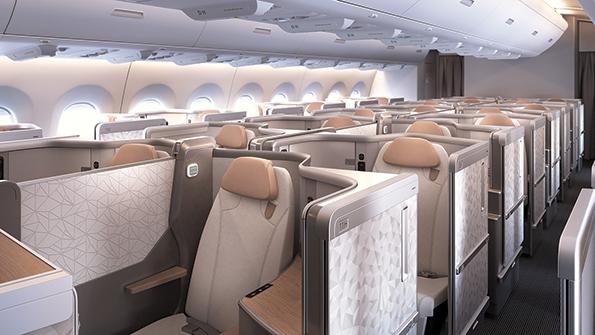
Recaro has a leading share of the economy-class market but wants to expand in the business-class segment.
At the end of 2019, Mark Hiller thought things could not continue as they had been for his company, Recaro Aircraft Seating—its revenues had increased more than 20% in the previous two years, exceeding €700 million ($755 million) in annual sales.
“We were extremely successful,” the Recaro CEO recalls. But then the Boeing 737 MAX suffered a prolonged grounding, a much more forceful debate about aviation and sustainability began, and Airbus orders declined. Hiller conservatively planned for a 25% decrease, to be on the safe side.
- Recaro Aircraft Seating sees strong demand return
- Delayed parts trigger complex schedule shuffling
Of course, what happened next was nowhere near what anyone anticipated. Starting in March 2020, airlines around the world canceled most of their flights and went into survival mode, stopping any capital investment they could. Most important, no new aircraft orders came in, and many deliveries were deferred. Airlines that do not take new aircraft or spend money on retrofits have no need for seats. In short, Recaro’s revenues did not drop 25% in 2020—they fell 65%.
The battle that followed is one most cabin suppliers have fought: raising financing when bank credit is impossible to get, deferring investment, trying to retain as much staff as possible to be ready for the restart, constantly negotiating with airlines and aircraft manufacturers, attempting to understand the situation and when things will change for the better—all while simply working to survive.
Three years on, the challenge is no longer survival. The focus now is orchestrating the ambitious growth plans of the industry at large, driven by aircraft orders and production targets set by Airbus and Boeing. Recaro’s challenges are a case in point.
In 2021, revenues plunged from the all-time high of €700 million to €265 million. The second year of the pandemic was even worse, due in large part to the operational issues that began to surface at aircraft OEMs, supply chain constraints elsewhere, travel restrictions and pandemic regulations. Recaro offered its German employees a no-layoffs guarantee that would last until the end of 2023 in return for a 10% pay cut. Short-time work, financed by the federal government, also was put in place. Recaro cut around 600 jobs outside of its home country. Losses were put into the planned budgets for 2020-23, and a large government-backed loan was taken to shore up liquidity.
This year, Recaro does not expect to return to the peak levels of 2019. The company anticipates around €500 million in revenue, which should enable it to make a profit, given its current size and industrial setup.
The fact that the current-year performance will not be better than 2019’s does not have to do with customer demand. Recaro has the capacity to build a lot more seats, but its supply chain is still struggling, and Hiller does not see any improvement between now and the end of the year. Sometimes all that is missing are chips for the inflight entertainment (IFE) system, which can be dealt with fairly simply, as IFE monitors typically can be plugged into finished seats at the last minute. “What is becoming difficult is when cables are affected,” as they are installed much earlier in the process, Hiller tells Aviation Week.
Limited visibility is a huge issue, too. One supplier missing a part “can slow down the entire supply chain,” he says.
Delays in major programs such as the Boeing 777X or the extra-long-range Airbus A321XLR are becoming a big “cash flow issue,” Hiller says. Investment in seat products for those variants has turned out to have been premature, with revenues planned against it coming in only much later.
Capacity planning is always in play, with many variables for seat manufacturers. A six-month lead time from order to delivery is not uncommon, yet the production outlook for new aircraft keeps changing—typically downward—and it needs to be coupled with market share assumptions. And then there is the retrofit market, which has been dead for several years but is returning now that airlines are willing to spend money again.
In order to react more quickly, Recaro has introduced Sprint, a standard, economy-class seat product geared at lessors that the seat manufacturer is aiming to deliver eight weeks after order intake. The business is mainly for aircraft that are transferred from one operator to another on short notice, which has become more common lately. It typically involves small quantities, but the deals are profitable anyway and serve as an introduction to new customers that may build larger fleets later.
Recaro is the leader of the economy-class seat market and has about a 30% global share of the business. The segment has been growing, as low-cost carriers expand and leisure demand comes back faster than premium. However, the company wants a larger share of the premium seats pie—where companies like Safran and Collins Aerospace are much stronger. Recaro’s large projects for 2023 include new business-class seats for Air China and Iberia, Hiller says. The company also is building premium-economy seats for Emirates—a huge order, given the size of the airline’s fleet.
In economy-class configurations, particularly for long-haul products, the challenge is to add more comfort features with limited weight impact. Recaro has been introducing headrests that move in various directions, longer seat cushions and footrests. On short-haul seats, power supply is becoming more common. Yet economy seats are around 50% lighter than they were 10 years ago, Hiller says. The key is to continue exploring more lightweight materials and find better designs that require less material.


